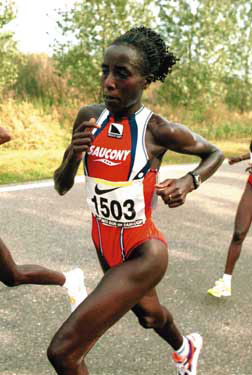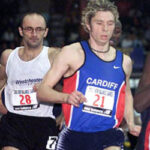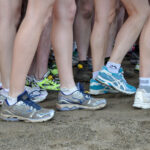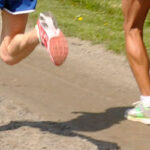Lornah Kiplagat – I want to be the best by Paul Grech
It has been described as one of the most entertaining 10,000m races in the history of the event. The women’s 10,000m was a great way to round off the first day of the World Championships, a great advert for an event that is often considered to be tedious and boring. Four athletes stood grouped together up till the final fifty metres, alternating the leadership of the race between them with each one egging on the others to keep up their pace and rhythm. In the end, it was a pity that one of the four had to stay out of the medal zone.
That fourth athlete was Lornah Kiplagat, “Of course [I will try to get] the best possible result. I am going for a place on the podium and I will fight for it,” she said before the
start of the championships. “If it doesn’t work, too bad. It is my first season on the track, my first World Championships, my 2nd 10,000 meter ever so I can’t expect too much.”
And indeed, it wasn’t to be. In those final fifty metres, Berhane Adere, Werknesch Kidane and Yinglie Sun had that little bit more in reserve and this allowed them to claim the medals. A disappointment for the long distance runner who was representing Holland for the first time – and indeed her finishing time of 30:32.03 set a new Dutch record – but one that she’ll take into her stride just as she has done with every other challenge.
Growing up in a country – Kenya– where most of the attention is devoted to men, her strength of character saw her drop her studies in order to embark on what eventually was to prove to be a successful athletics career.
The world record holder over the ten-mile distance – not to mention a winner of some of the major marathons across the globe – Kiplagat is now undoubtedly one of the major stars of her sport. And she is determined to make the most of her status. Contrary to many other athletes, however, this doesn’t mean an interest to get better sponsorship deals but the willingness to get involved in projects that actually make their mark on society.
The best example is the High Altitude Training Centre that Kiplagat opened last year in Iten, Kenya. That European athletes will also use this training centre is secondary to the fact that it will help female Kenyan runners who often have to struggle against social and cultural barriers.
She spoke to Paul Grech about her career so far, what brought about the decision to start representing Holland and why getting involved in projects that help the community is so important for her.
When you were growing up, was it always your dream to become a runner? Was it a priority?
I grew up in Kabiemit in the Rift Valley, Kenya. I did athletics in school but never thought about having a running career because I wanted to become a doctor. My priority was to study so that I could study medicine later on. After high school I found out I was good [at running] and developed it instead of going to University. At the time, I already had a scholarship for India for Medicine.
For young male Kenyans, the hero was probably Kip Keino. Who did you and other young female athletes look up to?
My hero was Susan Sirma, the first African woman to win a medal in the World Championships. She is a relative and helped me to become a professional runner.
Did your family easily accept your decision to become a runner? And was it easy to find training opportunities? In short, what sort of difficulties did you have to overcome to become a runner?
They didn’t accept because they wanted me to study. Only when I became really good they accepted it. For a woman it was very hard to find training facilities and it was a very tough time for me. Finding a place to sleep when you go to races, getting into races…many difficulties. That’s the main reason I started the Camp in Iten, so that young girls don’t have to go through the same thing.
Are women runners given the same importance as men in Kenya? Why?
Men are the most important and this has always been like that. This is just a culture thing: men are important, women are not. Because of the successes of Catherine Ndereba, Joyce Chepchumba and me this is now changing. We also express ourselves better to the press in Kenya so that people understand that things have to change.
Kenyans dominate distance running. What is the secret behind this success? Is it the ability to know when and how much to rest, as Moses Kiptanui suggests?
There is no secret at all. We always say it is the two A’s: Altitude and Attitude. Kenyans used to work extremely hard and focus on training and rest a lot. They live at high altitude so this helps. However, their dominance is getting less because of poor coaching, no structure and luxury. You see that other countries like Ethiopia and Morocco are coming up.
You have decided to run for Holland. How difficult was it for you to take that decision? And why did you decide to do so?
This decision was not difficult at all because I am married to a Dutch so I belong in Holland. The Federation in Kenya has never done anything for me and never invited me for any Championship so why should I not change? Now I just have to run the IAAF qualification standard and I am in the team. The Dutch federation is very supportive and all these things give peace in the mind so that you can perform better.
How do you judge your season so far?
The season is going on well. I have made the decision to change my training schedule completely and focus more on the track so that cost some time. However, I ran pretty well although I know I’m not there yet, I still need another year.
With the withdrawal of Paula Radcliffe, the distance running events were portrayed as being an anti-climax before they even started. Does this frustrate you?
I think this is complete nonsense. I was extremely disappointed that Paula can’t run but it also means that she probably trained too hard, went too fast in London or whatever. People who are not competing have no right. I really feel sorry for Paula because she is a great athlete and she indeed would have performed very well. I always want to compete with the best but if they are injured it is too bad. Paula never performed well on the track in big championships so what’s the problem? Of course she is a better athlete now but I am sure she will be back in Athens and we will make it a great race. I just hope she will be soon OK again.
Apart from competitive running, you’re also working very hard to promote your High Altitude Centre. First of all, when did you first think of setting up such a centre? How difficult has it been to get so far?
I started thinking on it already in 1995 when I started running and had so many difficulties. It is now not difficult at all because we have very good people taking care of the camp. We have 12 people full time working and they do a great job so I don’t have to worry that much. Only out of the season am I involved a lot but not right now.
What sort of facilities do you offer? And what has been the response – particularly from European athletes – so far?
We have 18 double rooms with hot water, shower and toilet, we have a restaurant with two cooks, we have a 400meter track and hundreds of Miles with dirt roads. The reactions are unbelievable, 99 % is coming back in a great shape and they improved a lot. The complete Dutch National team is training at the HATC and they did very well this season. Also marathoners improved a lot. Luc Krotwaar went from 2:12 to 2:10.
It has been widely publicised that you are using the HATC to offer more opportunities to young Kenyan athletes, particularly female athletes. In what way are you helping them and why do you feel this is so important?
We give them a room, we give them coaching, we feed them, we educate them and we give them a future. It’s way beyond only running. We make them to understand that being a woman doesn’t mean you have no rights. We teach them how to use computers, we teach them how to talk to the media, etc. I think this is extremely important and we already see a difference in attitude.
What are the goals that you have set for the centre and the athletes involved in the project? Are you looking for any particular results?
We want to have three athletes in the Olympics in Athens next year. We are working very hard and I do think we have some good chances.
You have started training a group of beginners in Puerto Rico. How did this come about and what does it involve?
This came because of some friends from the Primera Hora, the National newspaper in Puerto Rico. They were overweight and we told them to start running and made a deal that they would do the World Best 10 K in February. We started with 6 people but it became at the end a group of over 500 people. They all ran in the race and most of them finished. They were very happy and many people told us we gave them a new life. Every week we had a column in the paper with training schedule, nutrition tips, equipment tips, injury prevention, etc. Lots of work but it gave a great feeling to see them running last February. Now they are in training for the ING NYC Marathon!
It is evidently very important for you to use sport to help society. However, how useful can sport and what do you think can be achieved through sport?
Sport is extremely important because it brings people together. If you are a CEO of IBM or collecting garbage, you all look the same in your running outfit. Sport is the perfect way to communicate and it is a very powerful tool. People who train feel better, look better and can handle more stress. We are convinced that through the sport we can create a better World.
Finally, what aims and goals do you have for the future?
First of all to stay as happy and healthy as I am right now. Secondly, I want to extend our support to the people in Kenya and other East African countries and finally: I want to become the best runner in the World.
More information about Lornah Kiplagat and the HATC can be found at www.lornah.com
































